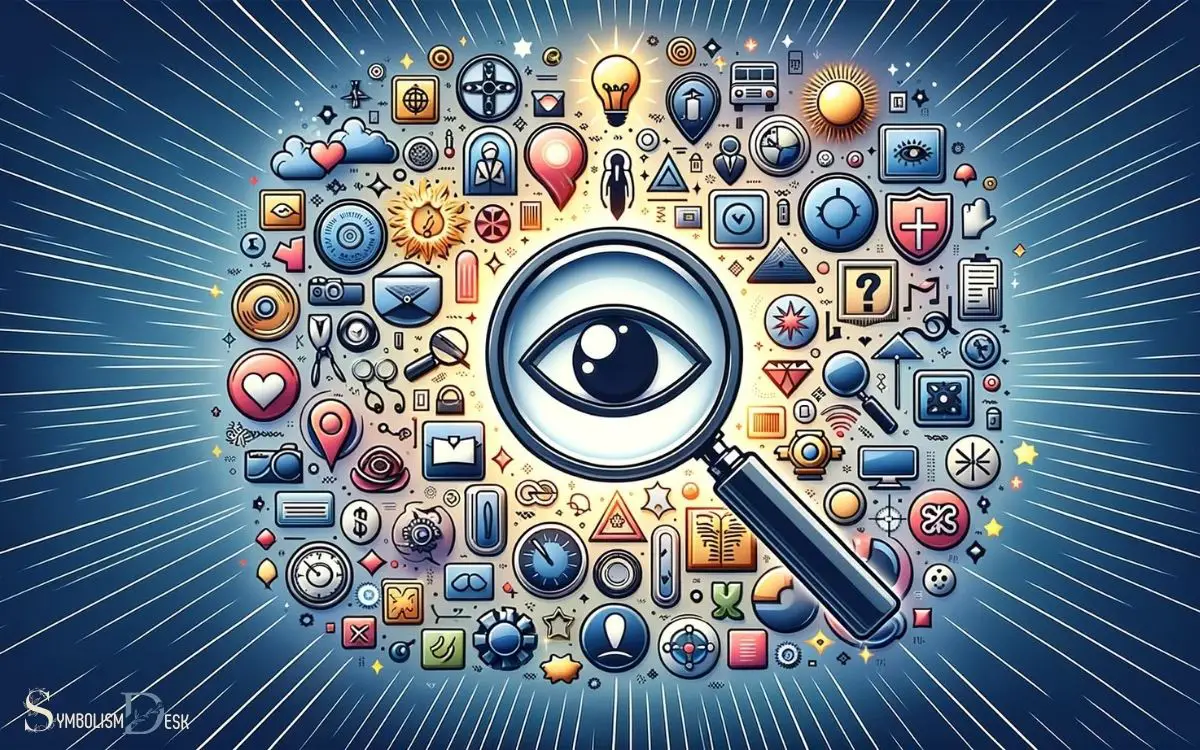The Symbolic Meaning of Visual Signs and Imagery Is Called
Semiotics is the study of the symbolic meaning of visual signs and imagery.
Semiotics, a term coined by philosopher Charles Sanders Peirce, is the discipline that interprets the meaning and use of signs and symbols in communication. It encompasses the analysis of anything that can stand for something else, and is often divided into three branches:
- Semantics: The relation between signs and the things they refer to.
- Syntactics: The relations among signs in formal structures.
- Pragmatics: The relation of signs to their effects on those who use them.
For example, a red octagon is widely recognized as a stop sign, where the shape and color both serve as visual cues to convey the message to halt.
Semiotics unravels the complexities of visual communication, allowing for deeper interpretation of our media-saturated world.

Key Takeaway
Origin and Evolution of Semiotics
The origin and evolution of semiotics can be traced back to ancient civilizations, where the study of signs and symbols began to develop as a means of communication and representation.
The ancient Egyptians, for example, used hieroglyphics as a form of written communication, and their intricate symbolism laid the groundwork for the study of semiotics. Similarly, the Greeks and Romans employed symbols in their art and architecture to convey specific meanings and ideas.
Over time, this study of signs and symbols evolved into a broader field of inquiry, encompassing not only linguistic signs but also non-verbal and visual signs.
Today, semiotics plays a crucial role in fields such as linguistics, anthropology, sociology, and communication studies, as it offers a framework for understanding how meaning is created and communicated through signs and symbols.
Key Concepts in Semiotics
An understanding of key concepts in semiotics is essential for grasping the complexities of visual signs and imagery.
Semiotics, as a field, encompasses various fundamental concepts such as signs, symbols, signifiers, signified, denotation, connotation, and codes.
Signs are the basic units of semiotics, representing something else to someone in some capacity.
Symbols, on the other hand, are culturally constructed and carry specific meanings within a particular society or group.
The relationship between the signifier (the form that the sign takes) and the signified (the concept it represents) is crucial in semiotics. This relationship is often arbitrary, meaning there is no inherent connection between the signifier and the signified, but it is maintained through shared cultural or social conventions. For instance, language, art, and even symbolic form in mathematics rely on this dynamic interplay between form and meaning to convey complex ideas and concepts. Understanding this connection helps to illuminate how meaning is constructed and communicated across diverse systems of representation.
Furthermore, denotation refers to the literal, primary meaning of a sign, while connotation refers to the secondary, implied meaning.
Understanding these key concepts provides a foundation for analyzing and interpreting visual communication in various contexts.
Transitioning into the subsequent section about ‘semiotics in advertising and marketing’, these concepts serve as the building blocks for understanding how meaning is constructed and communicated through visual signs and imagery.
Semiotics in Advertising and Marketing
Semiotics plays a crucial role in advertising and marketing. It helps decode the symbolic meaning of visual signs and imagery.
Understanding the impact of visual communication on consumer behavior is essential for crafting effective marketing strategies.
Visual Communication Impact
Visual communication plays a crucial role in advertising and marketing by conveying messages through images, symbols, and design elements. It has the power to evoke emotions, create brand recognition, and influence consumer perceptions.
The use of color, typography, and layout in visual communication can shape the way a brand is perceived and remembered.
In advertising, striking visuals can capture attention and communicate the essence of a product or service more effectively than words alone.
Similarly, in marketing, visual content on digital platforms can engage audiences and drive conversion rates.
Understanding the impact of visual communication is essential for creating compelling advertising campaigns and marketing strategies that resonate with target audiences.
This understanding of visual communication’s impact leads us to the subsequent section about consumer behavior analysis.
Consumer Behavior Analysis
The understanding of consumer behavior through semiotics in advertising and marketing is essential for decoding the symbolic meaning of visual signs and imagery.
Semiotics, the study of signs and symbols and their use or interpretation, provides valuable insights into how consumers perceive and interact with visual stimuli in advertising.
By analyzing the signs and symbols present in advertisements, marketers can gain a deeper understanding of how their target audience interprets these visual cues and how it influences their purchasing decisions.
Semiotics allows marketers to uncover the underlying meanings and associations that consumers make with specific visual elements, enabling them to create more impactful and culturally relevant advertising campaigns.
This deeper understanding of consumer behavior through semiotics can significantly enhance the effectiveness of marketing strategies and communication with the target audience, ultimately leading to more successful brand engagement and sales.
Transitioning into the subsequent section, an exploration of the cultural interpretation of visual signs further underscores the significance of semiotics in advertising and marketing.
Cultural Interpretation of Visual Signs
The cultural interpretation of visual signs plays a crucial role in understanding the diverse meanings and connotations attached to symbols.
Visual symbols carry significant cultural implications, and their interpretation varies across different societies and communities.
Exploring the cultural significance of imagery helps in comprehending the nuanced ways in which visual signs communicate and resonate with diverse audiences.
Interpreting Visual Symbols
Interpreting visual symbols within different cultures requires a nuanced understanding of the underlying meanings and associations embedded within the imagery.
Visual symbols often carry diverse interpretations across cultures, making it essential to comprehend the specific cultural context in which the symbols are being analyzed.
The following table provides a glimpse of how visual symbols can vary in meaning across different cultures:
| Visual Symbol | Western Culture Interpretation | Eastern Culture Interpretation |
|---|---|---|
| Dragon | Often associated with evil and danger | Symbol of power, strength, and good fortune |
| Color White | Represents purity and innocence | Symbolizes death and mourning |
| Owl | Symbol of wisdom and intelligence | Often associated with bad luck and death |
| Lotus Flower | Symbolizes purity and enlightenment | Represents beauty, grace, and spiritual growth |
Understanding these variations is crucial for effective communication and interpretation of visual symbols in a global context.
Cultural Significance of Imagery
Visual symbols play a pivotal role in conveying cultural significance through their interpretation and representation within different societies.
The cultural significance of imagery lies in its ability to encapsulate the values, beliefs, and traditions of a particular community.
This significance is derived from the shared understanding and interpretation of visual signs within a specific cultural context.
For instance, the use of certain colors, animals, or objects in visual imagery can hold deep cultural meanings that may vary across different societies.
Understanding the cultural significance of imagery requires an awareness of the historical, social, and religious contexts within which these symbols are embedded.
It is through this understanding that the cultural interpretation of visual signs becomes a powerful tool for communicating and preserving the rich tapestry of diverse cultural traditions.
Semiotics in Art and Design
Semiotics in art and design plays a crucial role in understanding the underlying meanings and messages conveyed through visual signs and imagery.
It provides a framework for analyzing how symbols and imagery are used to communicate specific ideas and concepts.
In the context of art and design, semiotics involves the study of how signs, symbols, and visual elements are intentionally arranged to create meaning.
This understanding is essential for artists and designers as it allows them to create work that effectively communicates their intended message to the audience.
Semiotics also enables viewers to interpret and understand the symbolism and messages embedded within artistic and design work, fostering a deeper appreciation and comprehension of visual communication.
What is the Symbolic Meaning of Visual Signs and Imagery in Relation to Navigation and Direction?
Visual signs and imagery play a significant role in navigation and direction, providing a symbolic meaning of compass. The compass, with its cardinal points, represents guidance and orientation. Visual signs such as arrows and road signs also convey essential information to help people navigate their surroundings effectively.
Practical Applications of Semiotics
The practical applications of semiotics in art and design extend to the strategic use of visual signs and imagery for conveying nuanced messages and eliciting specific responses from the audience.
By understanding the underlying meanings of symbols and signs, artists and designers can create visuals that resonate with viewers on a deeper level.
This can be particularly useful in advertising, where the goal is to evoke particular emotions or associations with a product or brand.
Below is a table illustrating practical applications of semiotics in art and design:
| Application | Description | Example |
|---|---|---|
| Advertising | Using symbols to evoke emotions | Using a heart symbol for love |
| Branding | Creating logos with symbolic meanings | Apple logo representing innovation |
| Web Design | Incorporating culturally relevant icons | Using a thumbs up icon for approval |
Conclusion
The study of semiotics offers a profound understanding of the symbolic meaning of visual signs and imagery. Semiotics helps us to decipher the messages and cultural references embedded in images, allowing us to explore the deeper meanings of visual communication. By analyzing the use of color, shape, and composition, we can gain insight into the complex web of associations and connotations that these symbols carry. Exploring compass symbolic meaning can reveal the ways in which visual signs are used to convey both universal and culturally specific ideas and beliefs.
It has evolved over time to become a crucial tool in advertising, marketing, art, and design. By interpreting cultural symbols and signs, semiotics allows for deeper understanding and communication across various contexts.
Its practical applications make it an essential area of study for those seeking to understand the power of visual communication.






